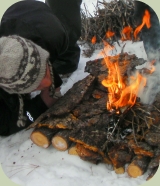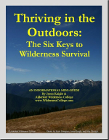Survival Skills You Need to Know
Basic Survival Skills

By Filip Tkaczyk
At that place is so much information on basic survival skills that you might exist asking "Where to outset?" Here are 6 chief components of wilderness survival to aid you thrive in any situation.
6 Basic Survival Skills:
Number ane: Mental attitude
More than any other skill, your mental attitude determines how successful you are in a survival situation. This kickoff of the basic survival skills might even determine whether you live or die!
To kickoff, consider "The Dominion of Threes." A homo can survive for:
- 3 minutes without air
- 3 hours without a regulated body temperature (shelter)
- 3 days without water
- iii weeks without food
The "Rule of Threes" provides a guideline of how to prioritize basic survival skills: first shelter, then water, and lastly food.
Surviving a hard wilderness situation as well requires meeting many challenges while avoiding panic. When faced with a potential survival situation, recollect to use a "SPEAR":
Southtop
Plan
Execute
Assess &
Re-evaluate
By systematically assessing, planning, and executing your basic survival skills, you will help continue your mind and body actively engaged in addressing your situation. This volition greatly assistance in fugitive panic and other negative states of mind. Past upholding an upright attitude, your chances of survival are greatly improved!
Number 2: Shelter
Many people who are forced into survival situations often become into serious problem considering of direct exposure to the elements. Most people in survival situations die of hypothermia, which tin be easily avoided with basic survival skills. Being able to build a shelter is of paramount importance in a survival situation. It is extremely important to prevent or minimize heat loss, or if in a desert environment, to minimize water loss. Hither are some things to think near when planning to build a shelter:
Shelter Considerations:
- Location (away from hazards, well-nigh materials)
- Insulation (from ground, rain, air current, air)
- Heat Source (body oestrus or fire-heated)
- Personal or Group Shelter
There are many types of shelters to consider including natural shelters such as caves, hollow stumps and logs, also as building shelters such every bit a droppings hut, lean-to, debris tipi, scout pit or snow shelter. Of the shelters listed, the debris hut is often the near applied to construct in almost whatsoever surroundings. Acquire how to construct a debris hut.
Number 3: Water
Since the human torso is composed of upwardly to 78% water, it should be no surprise that water is higher on the list than burn or food. Ideally, a person should drink about a gallon of water per day. Many lost persons perish due to aridity, and/or the debilitating effects of water-built-in pathogens from untreated h2o. In addition to water-borne pathogens, minerals and metals tin can be constitute in waters downstream from industrial and agricultural operations. The best sources for make clean drinking water in a wilderness setting are springs, head-water streams, and collecting forenoon dew.
Popular modern methods for purifying/treating water include filtering pumps and chemical treatments, such equally iodine. These can be efficient and effective solutions if you lot have admission to these items in a survival situation. An herbal treatment is another method in which water may be purified from viruses and leaner. Grapefruit seed extract is sold equally a water purifier, although in that location is some debate on whether or non it is one hundred percent effective. The most widely used and proven method for safely purifying water is boiling. Bringing water to a boil and allowing information technology to continue to boil for 2-iii minutes will impale bacteria and viruses.
By maintaining a level mental attitude, creating a shelter, and obtaining clean water, a person tin can successfully survive for many weeks.
Free Mini Survival Guide: "Thriving in the Outdoors"

In this 9-page guide, y'all'll find keys to starting a fire, building a shelter, purifying water, finding nutrient... and many more life-saving skills.
Get your Complimentary copy at present by signing up to our list. Discover more.
Number 4: Fire
Even though it is non direct a survival need, burn is i of the virtually useful bones survival skills. Information technology can help warm your body or your shelter, dry your clothes, eddy your water, and cook your food. Also, burn can provide psychological support in a survival state of affairs, creating a sense of security and safety.
Ideally, when traveling in the wilderness, information technology is best to carry multiple fire-starting tools, such equally a lighter, matches, flint and steel, etc… Even with these implements starting a fire tin be challenging in inclement atmospheric condition. Nosotros highly recommend practicing fire starting in different weather atmospheric condition inside dissimilar habitats. Good fire-making skills are invaluable. If you were to find yourself in a situation without a modernistic burn down-making implement, fire by friction is the most constructive primitive technique. Popular friction fire-making methods include bow drill, paw drill, fire plough, and burn saw.
Learn how to build a burn down using the bow and drill friction fire technique.
Number 5: Food
You might exist surprised to see food and then low on the bones survival skills priorities listing, though nosotros can survive for much longer without information technology equally compared with shelter and h2o. Remember "The Rule of Threes": humans can survive without food for roughly 3 weeks (though I'm sure you would not want to go that long without food!). Thankfully, most natural environments are filled with a variety of items that can meet our nutritional needs. Wild plants ofttimes provide the most readily bachelor foods, though insects and small-scale wild game can also support our dietary needs in a survival state of affairs.
Here are a few plants which are arable throughout North America:
Cattail: known as the "supermarket of the swamp", the roots, shoots, and pollen heads can be eaten
Conifers: the inner bawl, known equally the cambium, is full of sugars, starches and calories, and can be eaten on most evergreen, cone-bearing trees [except for Yew, which is poisonous]
Grasses: the juices from the leaves can provide nutrition, and the root corm can be roasted and eaten
Oaks: all acorns tin can be leached of their bitter tannic acids, and so eaten, providing an first-class source of protein, fats, and calories
Be sure that you properly identify any plant you program on consuming (using field guides and/or the guidance of an experienced expert). Many plants can be difficult to identify and some edible plants have poisonous look-a-likes. If y'all cannot place the plant, practice not swallow it.
Number half-dozen: Naturalist Skills
The more you know most nature, the improve you will be able to survive in the outdoors. To be great at wilderness survival, beyond the basic survival skills, requires an in-depth understanding of a variety of nature skills. For example, wildlife tracking skills allow ane to effectively locate wild game for food, and cognition of herbal medicine allows 1 to heal illnesses with wild plants. Especially for the situation where you may cull to purposefully do survival living for a lengthened flow of time, naturalist cognition is absolutely invaluable.
All of our hunter–gatherer ancestors had classification systems for living organisms, knew their names, understood their uses, recognized how they inter-related to each other, and were enlightened of exactly how to utilize those resources in a sustainable fashion. This cognition was at the foundation of their ability to thrive within the natural surroundings.
For fifty-fifty the recreational wilderness skills practitioner, a basic knowledge of the natural sciences (such every bit botany, environmental, geology, etc…) tin can be very useful and enriching. A great place to start is by purchasing the relevant plant and beast field guides for your region. These resources tin can help you begin to identify species and understand how they relate.
Now, with these six keys to basic survival skills, you are well on your fashion to thriving in the outdoors!
By the fashion, did you know that y'all can accept your outdoor skills to the next level through the Essential Wilderness Survival Skills online course? Go here for more than information.
Related Courses
Wilderness Survival Courses at Alderleaf
Additional Resources
Bank check out one of our favorite books on bones survival skills

Virtually the Author: Filip Tkaczyk is a periodic invitee teacher at Alderleaf. He as well wrote the field guideTracks & Sign of Reptiles & Amphibians. Learn more than near Filip Tkaczyk.
Return from Basic Survival Skills back to Wilderness Survival Manufactures
Cognition is Power - Grow Your Wilderness Skills! Get monthly updates on new wilderness skills manufactures, upcoming courses, and special opportunities. Join the free Alderleaf eNewsletter and equally a bonus you'll go our mini survival guide:
Source: https://www.wildernesscollege.com/basic-survival-skills.html
0 Response to "Survival Skills You Need to Know"
Post a Comment